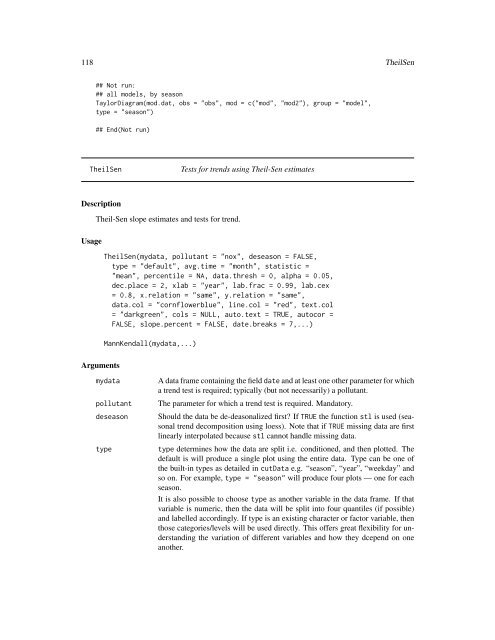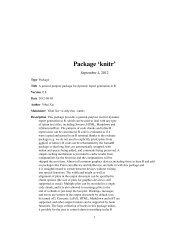Package 'openair'
Package 'openair'
Package 'openair'
You also want an ePaper? Increase the reach of your titles
YUMPU automatically turns print PDFs into web optimized ePapers that Google loves.
118 TheilSen## Not run:## all models, by seasonTaylorDiagram(mod.dat, obs = "obs", mod = c("mod", "mod2"), group = "model",type = "season")## End(Not run)TheilSenTests for trends using Theil-Sen estimatesDescriptionTheil-Sen slope estimates and tests for trend.UsageTheilSen(mydata, pollutant = "nox", deseason = FALSE,type = "default", avg.time = "month", statistic ="mean", percentile = NA, data.thresh = 0, alpha = 0.05,dec.place = 2, xlab = "year", lab.frac = 0.99, lab.cex= 0.8, x.relation = "same", y.relation = "same",data.col = "cornflowerblue", line.col = "red", text.col= "darkgreen", cols = NULL, auto.text = TRUE, autocor =FALSE, slope.percent = FALSE, date.breaks = 7,...)MannKendall(mydata,...)ArgumentsmydatapollutantdeseasontypeA data frame containing the field date and at least one other parameter for whicha trend test is required; typically (but not necessarily) a pollutant.The parameter for which a trend test is required. Mandatory.Should the data be de-deasonalized first? If TRUE the function stl is used (seasonaltrend decomposition using loess). Note that if TRUE missing data are firstlinearly interpolated because stl cannot handle missing data.type determines how the data are split i.e. conditioned, and then plotted. Thedefault is will produce a single plot using the entire data. Type can be one ofthe built-in types as detailed in cutData e.g. “season”, “year”, “weekday” andso on. For example, type = "season" will produce four plots — one for eachseason.It is also possible to choose type as another variable in the data frame. If thatvariable is numeric, then the data will be split into four quantiles (if possible)and labelled accordingly. If type is an existing character or factor variable, thenthose categories/levels will be used directly. This offers great flexibility for understandingthe variation of different variables and how they dcepend on oneanother.
















